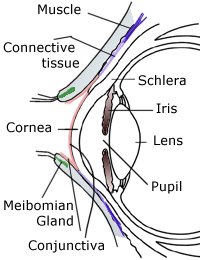Eye Infections
Treatment Types of eye infections Symptoms About inflammation About conjunctivitis News
Protecting the Eye
Our eyelids are the first line of defense protecting our eye. The eyelid provides a physical barrier to the outside environment with eye lashes to screen out large particles of dirt and dust as well as drops of sweat. The nasolacrimal ducts (tear glands), which are located at the inner corners of the eyes secrete fluid into the lacrimal sac which, when the eyelid blinks, pumps the tears onto the surface of the cornea. This creates a 3-layered tear film that protects the eye with lubrication, has antimicrobial properties, and additionally catches fine particles of dust which can then drain away from the eye. Along the edges of the eyelids, between the eye lashes, are meibomian glands that secrete a thin oily substance that helps keep the tear film from evaporating. Like other skin surfaces, the eyelid also includes sweat glands.
Eye infections can cause eye discomfort in a variety ways, including:
- Blepharitis is an inflammation or infection of the eyelid. It may occur on the front and outside of the eyelid (anterior blepharitis), commonly caused by bacteria. Or, it may occur on the inner moist lining of the eyelid (posterior blepharitis) caused by dysfunctional meibomian glands.
- Conjunctivitis (pink eye) is an inflammation or infection of the conjunctiva, which covers the eyelid lining and cornea surface. Allergic conjunctivitis is caused by allergies; viral conjunctivitis can develop along with colds or flu; and bacterial conjunctivitis generally requires antibiotics. Foreign material such as an acid or alkaline substance may also cause conjunctivitis, as well as infected insect bites, and some drugs.
- Styes are an inflammation or infection of an eye lash follicle.
- Chalazia develop if the meibomian glands become infected.
- Red, chronically irritated eyes. See dry eyes and computer eye strain.
 Next: Nutritional support,
diet, & lifestyle tips for eye infections.
Next: Nutritional support,
diet, & lifestyle tips for eye infections.
Symptoms
Red, itchy eyes, swollen, red eyelids, bumps on the eyes or under the lids
Be careful not to rub your eyes if your hands are unwashed. Women should make sure they are not using old make-up that can contain bacteria or other contaminants. Consider using organic, chemical-free makeup.
Eyelid Structure
 The eyelid is composed of some of the thinnest skin tissue in the body. Muscles, both
voluntary and involuntary, control the eyelid's opening and closing. The involuntary blink reflex, occurring nearly
instantaneously whenever something outside approaches, protects the eye from damage. The involuntary blink is fast: only 3/10ths to
4/10ths of a second.
The eyelid is composed of some of the thinnest skin tissue in the body. Muscles, both
voluntary and involuntary, control the eyelid's opening and closing. The involuntary blink reflex, occurring nearly
instantaneously whenever something outside approaches, protects the eye from damage. The involuntary blink is fast: only 3/10ths to
4/10ths of a second.
The conjunctiva, lining both the inside of the eyelid and the outside of the cornea and white of the eye serves as the next protective layer. It is lined with the conjunctiva, layers of tissue moistened by "goblet cells" that secrete mucin and form mucus and like the tear glands, produce some tears to help keep the eye moist. The conjunctiva contains tiny blood vessels that distribute nutrients and oxygen to the nearby tissue. It supplies the same elements of the immune system that other mucous tissues provide such as lymph cells.
The strong, clear cornea is the next line of defense for the eye. It acts as the outside lens of the eye "pre-focusing" light into the lens. It provides an estimated 65% to 75% of the focusing capacity of the eye. The cornea also helps filter out some of the damaging UV radiation that comes from sunlight.
The cornea has the capacity of healing quickly from minor scratches because when such an accident occurs; healthy cornea cells actually slide over to cover the scratched area.
Eye Infections News
Want to learn more? See our blog news on eye infections.
Treatment Causes Symptoms About inflammation About conjunctivitis News
 info@naturaleyecare.com
info@naturaleyecare.com



 Home
Home


 Vision
Vision Vision
Vision



 Health
Health Health
Health Research/Services
Research/Services Pets
Pets About/Contact
About/Contact


